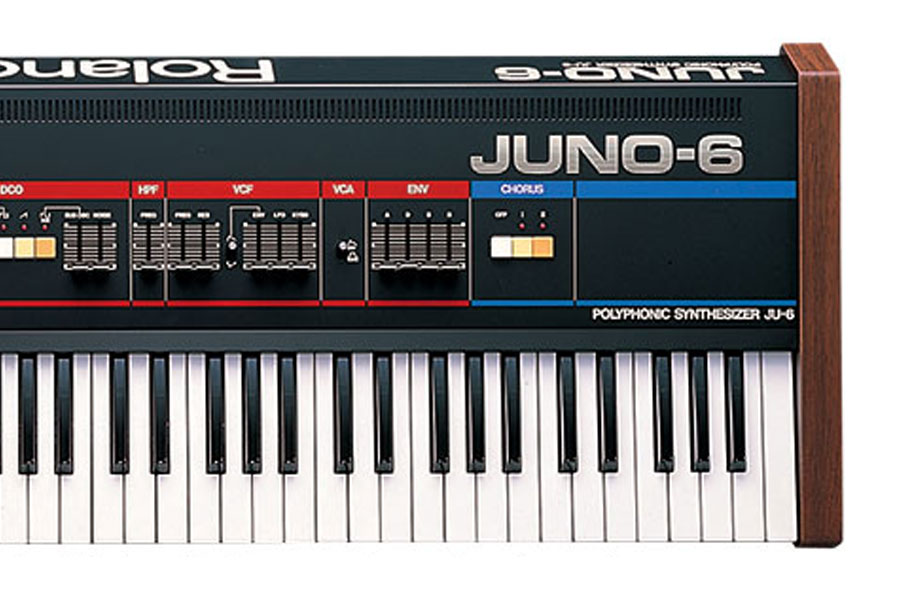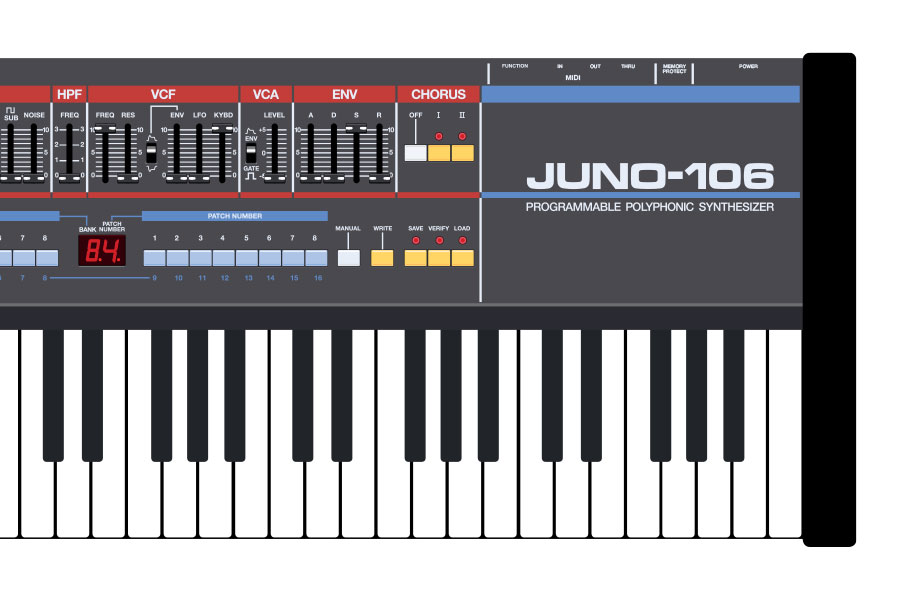JUNO
Legendary Heritage
Future Classic
THE JUNO
Four Decades of Classic Sound.
If you’re into synths, you’ve heard of the name JUNO.
Of course you have, that’s why you’re here.
There’s a lot of Roland synths that could we could write about, but in this article we are going to have a look at the milestone JUNOs that have been introduced over the years and hear why they are still sort after for their classic sound.

SONGS MADE WITH JUNO
There are so many great songs that have that classic unmistakable JUNO sound.
Warm, fat and very JUNO, the synth pads and riffs in these songs have become iconic to many synth pop lovers around the globe.
Why not hit play and continue reading about the most loved JUNOs and then learn about the amazing future of JUNO synthesis.

1982
JUNO-6

Ah, the JUNO-6, still so well loved. It only played six notes at a time but this analog synth used a Digitally Controlled Oscillator (DCO) per voice to generate notes. Traditional Voltage Controlled Oscillators (VCOs) were prone to detuning at high temperatures, leaving musicians ears hurting – but the new DCOs were completely reliable. The Juno-6 was the first analog polysynth that you could take on stage, turn on, and play with confidence knowing that the instrument would stay in tune. The built-in chorus effects fattened the sound of the single oscillator and begun the heritage of possibly one of the most famous and sort after choruses ever.
1982
JUNO-60

JUNO-60 was a landmark instrument that greatly influenced synthesizers to come. The JUNO-60 was almost identical to the JUNO-6 with the same filter but added the convenient ability to store sounds in onboard memories, up to 54 different patches in fact. It also added the then new DCB connection, which was the predecessor to MIDI. This meant you could hook up two JUNO-60s or a JUPITER-8 and have them play the same notes from one of the keyboards as well as change patches and control the other units VCF and VCA. This made this synth an instant classic.


1984
JUNO-106

The third of the Juno range, this six-voice subtractive analogue synth had fairly comprehensive MIDI, for the time anyway, and especially for an analogue synth. Some people say that the JUNO-106 is mellower, warmer and deeper and the JUNO-60 is more punchy and agressive.Just opinions though. Produced for four years, the Juno-106 is still very much loved and used today. Embraced by an even wider audience, the more affordable JUNO-106 went on to become one of the best-selling synths of all time.
Click HERE to learn more about the JUNO-106
2019
JU-06A

Combining the best of the JUNO-60 and JUNO-106 it has the high-pass filter of the 106, the envelope-controllable PWM of the 60, and the unique filter behavior of both, instantly switchable from the front panel. The sound is exactly like the originals, even while tweaking controls or using extreme settings. And being faithful to the vintage JUNO, it also has the swirling sound of its legendary chorus, faithfully recreated, right down to the lovable (and thankfully adjustable) noise.
Click HERE to learn more about the JU-06A



JUNO-X
- Three JUNOs in one, plus a LOT more!
This is definitely the next chapter in the JUNO legacy.
Standing among the greatest analog synthesizers ever created, Roland’s iconic JUNO lineup now has a new Queen with the distinctive and timeless classic JUNO sound but so very much more.
It delivers the full capabilities of the native ZEN-Core engine, along with genuine recreations of JUNO synths you can add other legacy Roland synths including the JUPITER-8, the JX-8P, SH-101, JD-800!
Learn More About ZEN-Core HERE
Can you tell the difference?
Watch Alex Ball compare the
JUNO-6, JUNO-106 and the JUNO-X!
In Alex’s original video he talks about the popularity of the JUNO and why we still care about these amazing synths.
In 1982, Roland released this “budget” synthesizer and on paper you’d expect it to have been forgotten within a couple of years, but the opposite is true.
In the full video HERE, Alex explores why that happened and looks at the modern successor, the JUNO-X.
We live in amazing times for synthesis, and it’s never been better.
Standing among the greatest analog synthesizers ever created, Roland’s iconic JUNO lineup has had a massive impact on music for over four decades. The warm, organic sounds of the JUNO-60 and JUNO-106 defined countless ’80s pop hits and played a huge role in the emergence of techno, house, synthwave, and other electronic styles. Distinctive and timeless, the classic JUNO voice continues to inspire leading music creators everywhere.
JUNO-X brings the best of the past together with Roland’s latest technologies, reimagining the vintage JUNO experience with vastly expanded sound possibilities and free-flowing tools tuned for today’s music. It delivers the full capabilities of the native ZEN-Core engine, along with genuine recreations of JUNO synths and other legacy Roland instruments.

